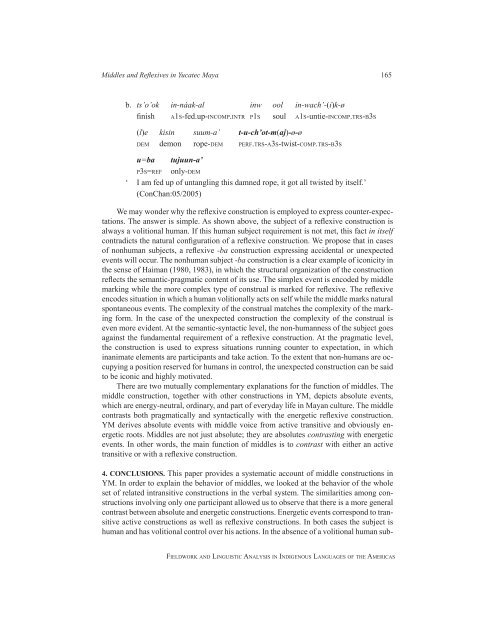Fieldwork and Linguistic Analysis in Indigenous ... - ScholarSpace
Fieldwork and Linguistic Analysis in Indigenous ... - ScholarSpace
Fieldwork and Linguistic Analysis in Indigenous ... - ScholarSpace
You also want an ePaper? Increase the reach of your titles
YUMPU automatically turns print PDFs into web optimized ePapers that Google loves.
Middles <strong>and</strong> Reflexives <strong>in</strong> Yucatec Maya 165<br />
b. ts’o’ok <strong>in</strong>-náak-al <strong>in</strong>w ool <strong>in</strong>-wach’-(i)k-ø<br />
f<strong>in</strong>ish a1s-fed.up-<strong>in</strong>comP.<strong>in</strong>tr P1s soul a1s-untie-<strong>in</strong>comP.trs-b3s<br />
(l)e kis<strong>in</strong> suum-a’ t-u-ch’ot-m(aj)-ø-ø<br />
dem demon rope-dem Perf.trs-a3s-twist-comP.trs-b3s<br />
u=ba tujuun-a’<br />
P3s=ref only-dem<br />
‘ I am fed up of untangl<strong>in</strong>g this damned rope, it got all twisted by itself.’<br />
(ConChan:05/2005)<br />
We may wonder why the reflexive construction is employed to express counter-expectations.<br />
The answer is simple. As shown above, the subject of a reflexive construction is<br />
always a volitional human. If this human subject requirement is not met, this fact <strong>in</strong> itself<br />
contradicts the natural configuration of a reflexive construction. We propose that <strong>in</strong> cases<br />
of nonhuman subjects, a reflexive -ba construction express<strong>in</strong>g accidental or unexpected<br />
events will occur. The nonhuman subject -ba construction is a clear example of iconicity <strong>in</strong><br />
the sense of Haiman (1980, 1983), <strong>in</strong> which the structural organization of the construction<br />
reflects the semantic-pragmatic content of its use. The simplex event is encoded by middle<br />
mark<strong>in</strong>g while the more complex type of construal is marked for reflexive. The reflexive<br />
encodes situation <strong>in</strong> which a human volitionally acts on self while the middle marks natural<br />
spontaneous events. The complexity of the construal matches the complexity of the mark<strong>in</strong>g<br />
form. In the case of the unexpected construction the complexity of the construal is<br />
even more evident. At the semantic-syntactic level, the non-humanness of the subject goes<br />
aga<strong>in</strong>st the fundamental requirement of a reflexive construction. At the pragmatic level,<br />
the construction is used to express situations runn<strong>in</strong>g counter to expectation, <strong>in</strong> which<br />
<strong>in</strong>animate elements are participants <strong>and</strong> take action. To the extent that non-humans are occupy<strong>in</strong>g<br />
a position reserved for humans <strong>in</strong> control, the unexpected construction can be said<br />
to be iconic <strong>and</strong> highly motivated.<br />
There are two mutually complementary explanations for the function of middles. The<br />
middle construction, together with other constructions <strong>in</strong> YM, depicts absolute events,<br />
which are energy-neutral, ord<strong>in</strong>ary, <strong>and</strong> part of everyday life <strong>in</strong> Mayan culture. The middle<br />
contrasts both pragmatically <strong>and</strong> syntactically with the energetic reflexive construction.<br />
YM derives absolute events with middle voice from active transitive <strong>and</strong> obviously energetic<br />
roots. Middles are not just absolute; they are absolutes contrast<strong>in</strong>g with energetic<br />
events. In other words, the ma<strong>in</strong> function of middles is to contrast with either an active<br />
transitive or with a reflexive construction.<br />
4. CONCLUSIONS. This paper provides a systematic account of middle constructions <strong>in</strong><br />
YM. In order to expla<strong>in</strong> the behavior of middles, we looked at the behavior of the whole<br />
set of related <strong>in</strong>transitive constructions <strong>in</strong> the verbal system. The similarities among constructions<br />
<strong>in</strong>volv<strong>in</strong>g only one participant allowed us to observe that there is a more general<br />
contrast between absolute <strong>and</strong> energetic constructions. Energetic events correspond to transitive<br />
active constructions as well as reflexive constructions. In both cases the subject is<br />
human <strong>and</strong> has volitional control over his actions. In the absence of a volitional human sub-<br />
fieldwork <strong>and</strong> l<strong>in</strong>guistic analysis <strong>in</strong> <strong>in</strong>digenous languages of the americas

















